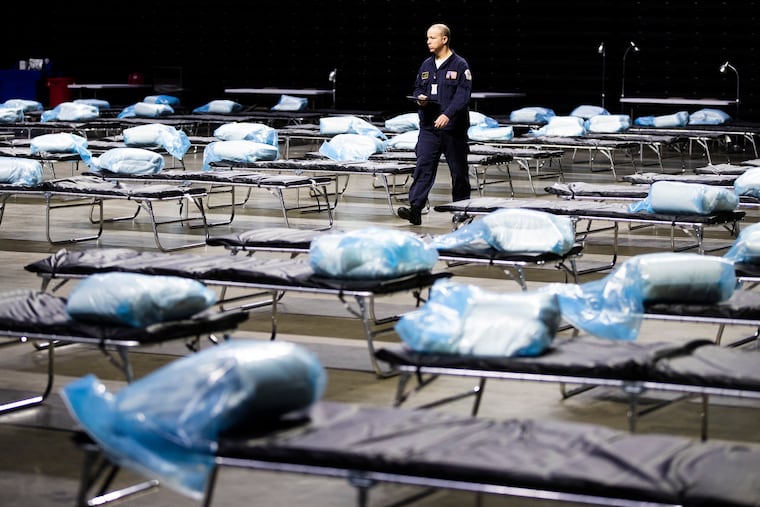COVID-19 is stressing some Philadelphia hospitals more than others, report suggests
The heaviest burden of COVID-19 patients at Philadelphia hospitals this week was at Nazareth Hospital in the Northeast.

This week Nazareth Hospital in Northeast Philadelphia had the city’s biggest COVID-19 burden relative to its size, with 64 COVID-19 patients in a facility with 145 beds, according to the Philadelphia Hospital Capacity Report issued Wednesday.
“This is the post-Thanksgiving surge we hoped would not occur,” Nazareth officials said in an email Thursday. “The data listed in the report is a snapshot in time and can change from hour to hour based on discharges and new patients coming in through the emergency department.”
The daily tally is kept by Public Health Management Corp., which coordinates health-care emergency management for the state. The detailed statistics are not released to the public — a reporter obtained a copy from a source — and are part of the information used by state officials to track hospital capacity and decide when to put restrictions on elective procedures. Hospital officials also use the information to coordinate among themselves because it enables them to see which hospitals are getting overloaded.
As the number of COVID-19 cases steadily increases, public health officials have been increasingly concerned about running out of beds. But so far officials haven’t gone as far as they did in the spring, when they established a surge hospital in Temple University’s Liacouras Center. The center was set up to accommodate 200 patients, but never held more than six patients at a time, city Health Commissioner Thomas Farley said in April.
Three large Philadelphia hospitals, Temple, Einstein, and Thomas Jefferson, usually have the largest counts of COVID-19 patients in the city, and these new statistics confirmed that. But that doesn’t mean they are bearing the biggest burden of COVID patients relative to their size.
A copy of the report, with Tuesday data, listed Temple University Hospital with 115 COVID-19 patients and 540 beds. That was the largest number of COVID patients in the city, but those COVID patients occupied a significantly smaller percentage of Temple’s beds. At its spring peak, Temple’s main hospital had more than 150 COVID patients, according to an investor presentation last month.
Einstein had 98 COVID-19 patients, according to Tuesday’s data, while Jefferson had 94 and Jefferson-Torresdale had 93.
Aside from bed availability, major concerns in the spring were shortages of personal protective equipment and ventilators.
Now, health-care executives say, the big problem is staffing. Some systems have hundreds of employees who can’t work because they are in quarantine after being exposed to someone with the virus, or have tested positive themselves.
Nazareth, which is part of Trinity Health Mid-Atlantic, outlined some of the steps it is taking to handle the surge of COVID cases: “These include temporarily closing our acute rehab unit to shift staff to where they are most needed, working with other area hospitals to transfer patients who may need higher levels of care than we can provide, calling on our pool nurses to work additional shifts, and implementing divert status for our emergency department.”
The emergency department is still open, and anyone with heart attack or stroke symptoms should still seek care, Nazareth officials said. Medical experts across the country have seen a surprising drop-off in patients with these symptoms, suggesting people are staying home out of fear of the virus, rather than getting help that can save them from serious debility or even death.
Outside the city, Gerard Cleary, chief medical officer and chief of staff at Abington-Jefferson Health, said Abington and Lansdale Hospitals are seeing increases in COVID and non-COVID patients and have opened overflow to expand capacity. Some federal data even suggested that Abington was full, but he said the hospital is adjusting to demand.
To increase staffing availability for patient care, “this week we decided to limit training and other work outside of direct patient care in order to keep our health-care workers and other frontline caregivers at the bedside to accommodate the increasing volumes,” Cleary said.
Main Line Health has four acute-care hospitals, including the smallest, Riddle Hospital in Media, with a total of 227 beds. At the end of November, Riddle was 69% full, and its ICU, with 57 beds, was 93% full, according to federal data analyzed by the New York Times.
Main Line’s interim Chief Medical Officer John Stallkamp said the system is doing several things to manage the surge in COVID-19 cases — as well as the usual surge of patients related to winter weather and holiday excesses.
The primary strategy is one that the state is trying not to mandate. “Main Line has postponed a significant number of elective surgeries at a significant cost to our bottom line,” he said. The system is also doing a lot of “load balancing,” Stallkamp said. For example, an emergency patient who needs admission might be transported from nearly-full Riddle to nearby Bryn Mawr Hospital.
Staff writer Marie McCullough contributed to this article.